10 Stunning Types of Magnolia Trees and Shrubs for Your Landscape
From stately southern magnolias to petite star magnolias, there is a type of magnolia tree or shrub for every landscape.
:max_bytes(150000):strip_icc():format(jpeg)/GettyImages-1304422754-ab9fb9b720f645fd9312abe1dc71f295.jpg)
photohampster / Getty Images
With so many spectacular types of magnolia trees and shrubs to choose from, it can be tough to choose the perfect one for your yard. Maybe you're drawn to the substantial flowers and bold fragrance of southern magnolias, or you enjoy star magnolia’s delicate blossoms announcing spring’s arrival. Some types are well-suited for the heat and humidity of the southern U.S., while others tolerate the frigid winters of northern regions. Some magnolias grow well in small-space landscapes, while others demand large yards to reach their full potential. Find the best types of magnolia for your yard with this guide.
Southern Magnolia
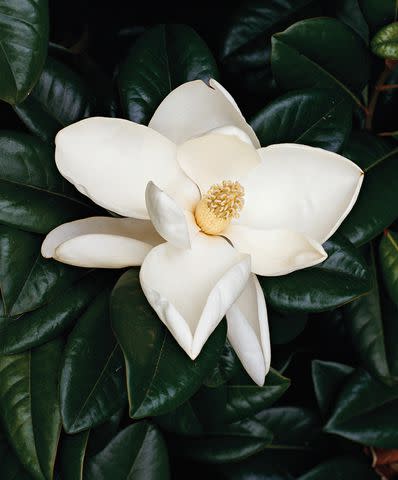
Mary Carolyn Pindar
Southern magnolia (Magnolia grandiflora) is a large evergreen tree that's native to the southeastern United States. The 10- to 12-inch-wide white flowers bloom in summer. The flowers are followed by brown fruits with bright red seeds. The oval-shaped, shiny, dark green leaves have fuzzy, rusty-brown undersides and are frequently clipped for wreaths, swags, and interior decor.
Plant southern magnolia where it has plenty of space to expand, or choose a smaller variety such as ‘Kay Parris’, ‘Little Gem’, or ‘Teddy Bear’. These varieties reach a mature size of 30 feet tall.
Growing Conditions: Part shade and moist, well-drained soil. It tolerates clay soil but does not grow well in wet or swampy areas.
Size: 60 to 80 feet tall and 20 to 40 feet wide
Zones: 6–10
Sweet Bay Magnolia
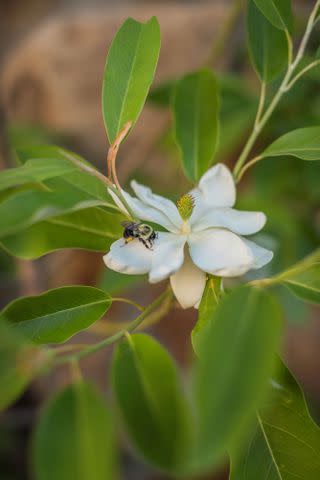
Bob Stefko
A North American native, sweet bay magnolia (Magnolia virginiana) is a small, slow-growing tree with fragrant white flowers and dark green leaves. If southern magnolia is too large for your landscape, sweet bay magnolia might be a good fit. In warm climates, this spring-flowering tree is evergreen; in cold climates, it often sheds its leaves. Unlike other magnolias, it thrives in moist and boggy soil. Plant it in low spots and wet sites in the landscape.
Growing Conditions: Full sun to part shade and consistently moist-to-wet soil. It tolerates boggy soil.
Size: 10 to 30 feet tall and wide
Zones: 5–10
Saucer Magnolia
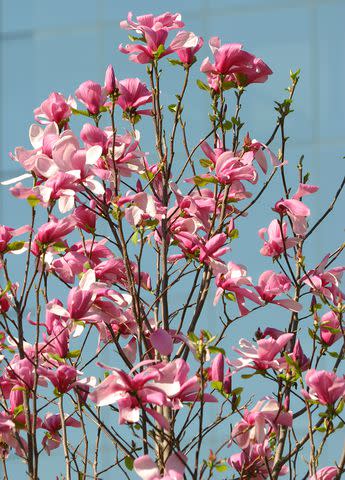
Large, cup-shaped flowers decorate the bare branches of this deciduous type of magnolia tree in late winter or early spring. Its prominent fuzzy buds add interest in winter and are popular for cut arrangements. Saucer magnolia (Magnolia x soulangeana) is a great shade tree for small landscapes. Pair it with other spring flowering small trees like serviceberry, crabapple, and redbud for a living screen along a property line.
Growing Conditions: Full sun to part shade and moist, well-drained soil. It grows best in consistently moist soil.
Size: 15 to 30 feet tall and 15 to 25 feet wide
Zones: 4–9
Related: 18 Small Trees for Front Yards That Explode with Color
Star Magnolia
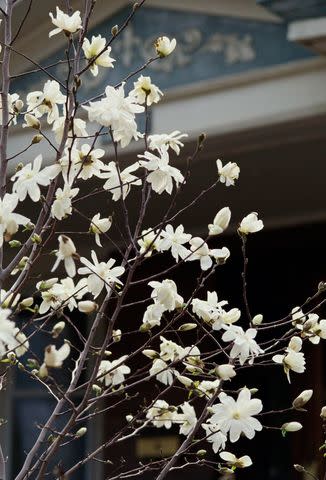
This petite type of magnolia has graceful—almost frilly—fragrant flowers. Star magnolia (Magnolia stellata) is covered with white or pink blossoms in early spring before the plant’s leaves emerge. A slow-growing deciduous shrub or multi-stemmed tree, star magnolia works well for small landscapes. Use it in a mixed shrub border or add it near a patio. This magnolia rarely needs pruning. ‘Royal Star’ is an excellent variety with double, snow-white flowers.
Growing Conditions: Full sun and moist, rich soil. It is adaptable to a variety of conditions.
Size: 15 to 20 feet tall and 10 to 15 feet wide
Zones: 4–9
Related: Yes, You Can Grow Magnolia Trees in Pots—Here’s How to Succeed
Loebner Magnolia
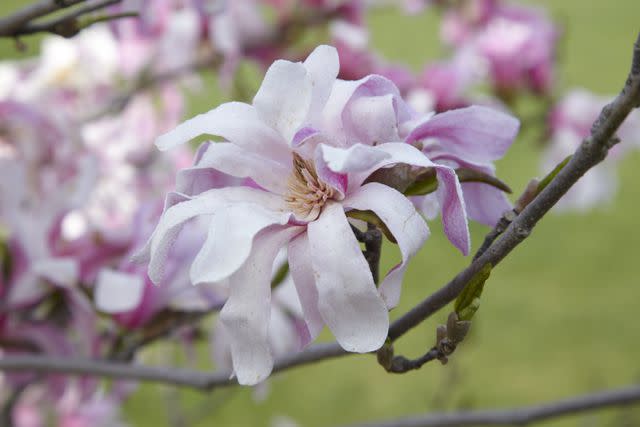
Dean Schoeppner
Loebner magnolia (Magnolia x loebneri) is a star magnolia hybrid. It has many-petalled flowers like star magnolia with a more robust, tree-like habit. Use Loebner magnolia as a medium-sized tree in the landscape. This deciduous magnolia blooms a couple of weeks later than star magnolia—mid spring in many areas. Grow ‘Merrill’ for its fragrant flowers. ‘Leonard Messel’ (shown here) is a pink-flowering variety.
Growing Conditions: Full sun to part shade and moist, rich, well-drained soil
Size: 15 to 30 feet tall and wide
Zones: 4–9
Cucumber Magnolia
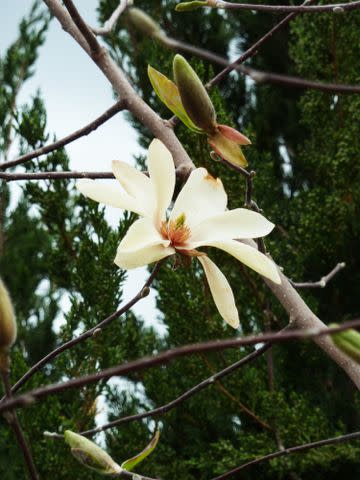
Denny Schrock
Yellowish tulip-like flowers decorate the branch tips of this native magnolia in spring. Cucumber magnolia (Magnolia acuminata) is deciduous with a pleasing pyramidal shape; it makes a great residential shade tree. It casts dense shade and rarely needs pruning. ‘Yellow Bird’, ‘Butterflies’, and 'Gold Star' (shown here) are a few popular varieties to look for.
Growing Conditions: Full sun and moist, rich, well-drained soil
Size: 30 to 40 feet tall and 25 feet wide
Zones: 5–9
Bigleaf Magnolia
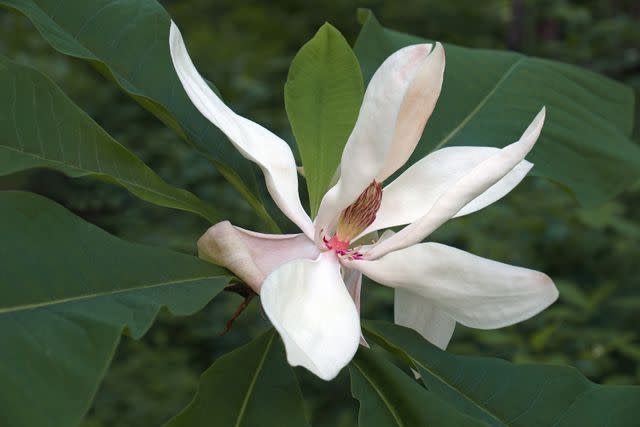
nickkurzenko /Getty Images
This type of magnolia tree is aptly named–the leaves of this North American native are huge! The 12- to 32-inch-long leaves are up to 12 inches wide. Bigleaf magnolia (Magnolia macrophylla) flowers are extra large too. Each fragrant flower is 8 to 12 inches wide. The trees are slow to bloom; they're usually 12 to 15 years old before they will flower. Bigleaf magnolia blooms sporadically from May to June, and is deciduous in most areas but semi-evergreen in Zone 8.
Growing Conditions: Full sun to part shade; tolerates a wide variety of soils
Size: 30 to 40 feet tall and 20 to 30 feet wide.
Zones: 5–8
Lily Magnolia
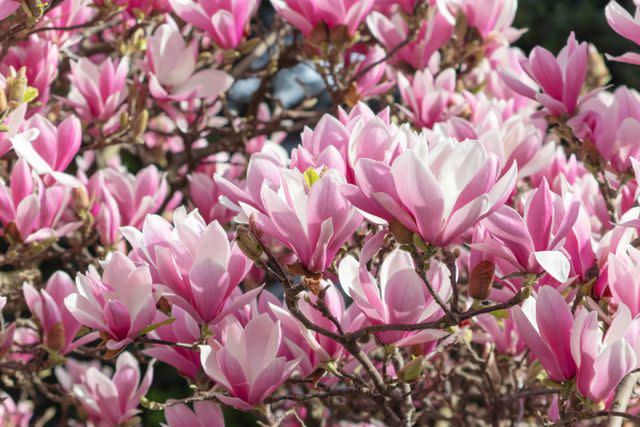
photohampster / Getty Images
A smaller type of magnolia tree, lily magnolia (Magnolia liliiflora) grows up to 12 feet tall. It is covered with lily-shaped flowers in spring before the leaves emerge. The flowers have a white interior and a purple-pink exterior. Several lily magnolia hybrids are available, such as the Little Girl series—‘Ann’, ‘Betty’, and ‘Jane’ are three examples.
Growing Conditions: Full sun to part shade and moist, well-drained soil. It grows best in soil that is moist but not soggy.
Size: 8 to 12 feet tall and wide
Zones: 5–8
Related: 10 Flowering Trees and Shrubs that Will Make a Statement This Spring
Kobus Magnolia
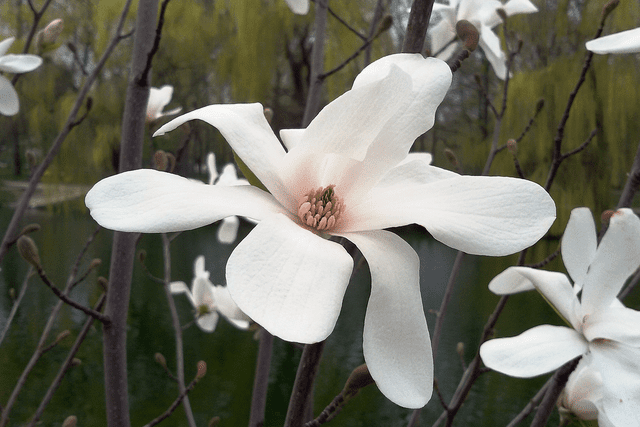
Alex Schadnev / Getty Images
A graceful multi-trunked tree, kobus magnolia (Magnolia kobus) has a shape and branching habit reminiscent of a stately live oak. Kobus magnolia blooms in early spring before the new leaves emerge. The 4-inch-wide, white or pink flowers are lightly fragrant. The tree drops its 4- to 8-inch-long leaves in fall. ‘Wada’s Memory’ is a popular variety with black-green leaves and large flowers.
Growing Conditions: Full sun and well-drained soil
Size: 25 feet tall and wide
Zones: 5–8
Yulan Magnolia
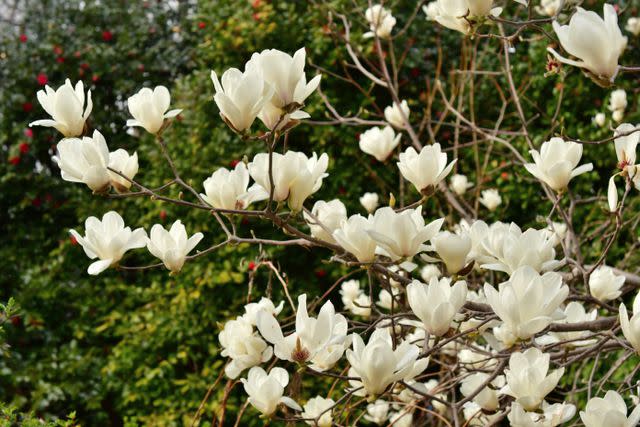
magicflute002 /Getty Images
A fast growth rate and striking dark green leaves make Yulan magnolia (Magnolia denudata) a welcome landscape tree. Count on it to grow 30 to 40 feet tall and wide and have a rounded outline. It is a multi-trunk tree with smooth bark and pendulous branches. Plant it near a patio or walkway where you can enjoy its attributes year-round. Lemon-scented, 6-inch-wide flowers decorate the tree’s bare branches in spring.
Growing Conditions: Full sun to part shade and moist, well-drained soil
Size: 30 to 40 feet tall and wide
Zones: 6–8
For more Better Homes & Gardens news, make sure to sign up for our newsletter!
Read the original article on Better Homes & Gardens.

